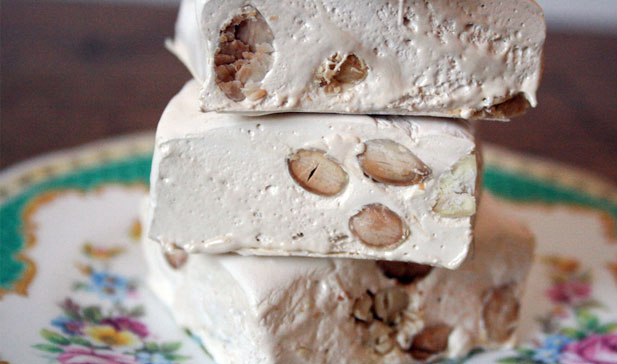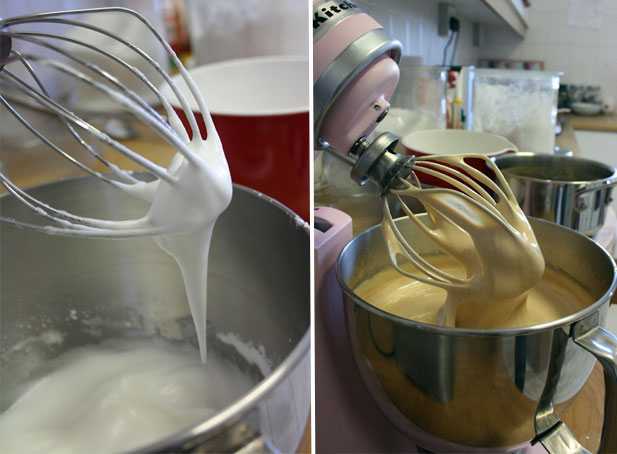The science behind nougat
 Contrary to what you might think, making nougat is pretty straight forward if you have the right tools and the right recipe. I found the trickiest part was scraping out the sticky batter into the pan! Download print-friendly version.
Contrary to what you might think, making nougat is pretty straight forward if you have the right tools and the right recipe. I found the trickiest part was scraping out the sticky batter into the pan! Download print-friendly version.
Nougat is a candy, which means its primary ingredient is sugar syrup. You can read a bit more about candies in the science behind fudge. The other main ingredient is egg white. Does it sound like a bit of a strange combination? Let’s find out how to combine the two. Most nougat recipes use honey and sugar for the syrup. After looking at a number of recipes, I decided to use 1 cup of honey, 3 cups of sugar and 3 egg whites.
 So our nougat recipe is as follows:
So our nougat recipe is as follows:
1 cup of honey
3 cups of sugar
3 large egg whites
1/2 cup icing sugar
2 cups toasted almonds
A few sheets of edible rice paper (also known as wafer paper)
 You will also need:
You will also need:
A 23cm x 23cm square pan
A heavy saucepan (if your pan is too thin the syrup might burn)
A candy thermometer
An electric mixer (a stand mixer is preferable)
A sharp knife
And here is our method:
1. Calibrate your candy thermometer so that the boiling point for water = 100°C. (You can refer back to the science behind fudge for more handy tips when it comes to using candy thermometers.)
2. Grease the pan with butter, or spray it with non-stick spray.
3. Line the bottom of the pan with the edible paper.
TIP: If you have to piece the paper together, try and make sure that there are no overlapping pieces, since they will make the cutting at the end a bit trickier.
4. Set aside the egg whites in the bowl of the stand mixer.
TIP: Make sure the whisk and bowl are completely grease free. You can make sure this is the case by wiping them with a bit of lemon juice before you start.
5. In your sauce pan, combine the honey and the sugar. Cook over a low heat and stir until the sugar has dissolved.
6. Raise the heat to medium, and place the thermometer in the sauce pan. Without stirring, continue to cook until the mixture reaches 158°C. At this point, immediately remove the mixture from the heat and leave it to cool for a minute or two.
7. While the sugar syrup is cooking, beat the egg whites into stiff peaks. Then add the icing sugar and beat until they are combined.
8. When the sugar syrup has cooled to about 145°C, slowly pour it into the egg white mixture, while the mixer is running. The mixture will increase in volume and look caramel coloured, but no need to panic, this is normal.
 9. Continue beating the mixture until it begins to thicken. (It needs to be thick, but not too thick to mix in the nuts and scrape into the pan).
9. Continue beating the mixture until it begins to thicken. (It needs to be thick, but not too thick to mix in the nuts and scrape into the pan).
10. Now fold in the nuts, and pour the nougat into the pan.
TIP: You may need a friend to hold the mixing bowl for you, as the mixture should be quite thick by now and VERY sticky.
11. Smooth out the top of the nougat, and cover it with rice paper.
12. Let it set at room temperature for about 12 hours.
13. Once it has set, you can loosen the sides and tip the whole block out of the pan.
14. Now it is ready to be cut! Make sure you have a big sharp knife to make cutting easier. Although it doesn’t really matter whether you cut it to perfection or not, it will still taste delicious.
 If you keep the nougat for more than a day, I would suggest wrapping the pieces in cellophane, as they absorb moisture and become sticky very quickly.
If you keep the nougat for more than a day, I would suggest wrapping the pieces in cellophane, as they absorb moisture and become sticky very quickly.
And that’s how you make nougat. Pretty straightforward, don’t you think? Once you’ve perfected your nougat making skills, you can substitute the almonds for any combination of ingredients – pistachios, hazelnuts, cherries or macadamias. Enjoy!
More in the Science Behind series:
The science behind pavlova
The science behind fudge
The science behind chocolate chip cookies
The science behind cupcakes
